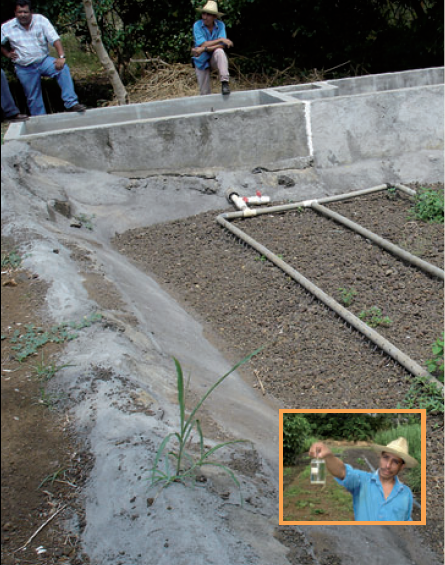Planted soil filter
Planted soil filters, also referred to as constructed wetlands or reed bed systems, are natural systems treating solid-free wastewater. This can be pre-treated wastewater from a flush toilet or faecal wastewater from a urine diversion toilet, either combined with wastewater from the kitchen and bathroom, or separate from it. A planted soil filter, preceded by a settling and watertight storage tank, consists of a sand and gravel matrix (sealed at the bottom) planted with wetland plants like reeds. Solid free wastewater is discharged from the storage tank on top of the filter or though an underground inlet-system and flows through (vertical) the filter. Horizontal-flow soil filters are commonly found, and easier to construct than vertical flow filters, but they are less efficient at eliminating nitrogen. Wastewater is treated through several processes, in which bacteria play an important role. After treatment, the effluent can be discharged into surface water, used for irrigation or groundwater recharge.
| Advantages | Disadvantages |
|---|---|
| Removes pathogens from wastewater. Effluent from wetlands can be used for irrigation. |
Considerably large area is needed for wastewater with high organic load. Some degree needed of post-treatment if the effluent is directly used for edible crop irrigation. |
Costs
- Costs can vary greatly, and depend, among other factors, on local availability of gravel, the kind of sealing and the cost of land.
- Investment costs on average US$ 585 per person (Germany, 2005).
- Investment costs 7000 inhabitants US$ 16 per person (Syria, 1999).
- Operational costs 7000 inhabitants US$ 1.17 per person, per year (Syria, 1999).
Applying conditions
- If planted soil filters are applied in hot climates with a continuous growing season, wetland biomass can be harvested.
- Planted soil filters can be implemented at household or community level. Their use in isolated settlements like rural schools is also possible.
- Design and construction require a solid understanding of the treatment process.
- The amount of technical equipment needed is very small.
External links
- General information about Planted soil filter www.bodenfilter.de/engdef.htm
- General information constructedwetlands.net
- General information www.gtz.de/ecosan
- General information www.sandec.ch

